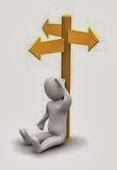What got you here won’t get you there. ~Marshall Goldsmith
“What got you here won’t get you there.” This is a quote I use frequently when working with organizations on strategic planning. It seems so easy to assume that if something worked in the past it will work in the future so why change anything. I hear that a lot, especially from nonprofits that have been around for decades. If we’ve been here for 100+ years, surely we’ll be here for 100+ more years, just because.
I had an experience last week that proved to me, in a very personal way, that what got you here clearly won’t get you there. I have a small lake cottage in West Michigan. For several years now I’ve periodically had plumbing problems. I’ve had plumbers out more times than I’d care to count and the problem continued to persist. So, as it began to act up, once again, I decided enough was enough and it was time to get a plumber who’d really diagnose the situation and help me get beyond putting band aids on the problem and be willing to do some surgery if that’s what needed to be done.
And diagnose he did! He climbed on the roof to check out the venting system, crawled in my well, and put a camera through the line to the septic tank. He determined that the line needed to be replaced. The lake cottage was built somewhere around 1950, or so. This line, which is 60 feet long, was made of clay tiles. That means each clay section of pipe was about two feet long and the sections were connected with concrete. Yikes! Yes, it clearly worked 60 or 70 years ago, but it’s no longer functioning and what got me here clearly wasn’t going to get me there. So the backhoe was delivered, the digging ensued and I now have a brand new PVC line from the cottage to the septic tank, with a few bells and whistles added which I won’t attempt to describe. But I learned that I can truly get excited about sewage that now flows in the proper direction!
You may think that this personal experience is a little extreme as an example of “what got us here won’t get us there.” I’ve worked with enough leaders who want to believe that what worked for their organization the last several decades will continue to work in the coming years, to know that sometimes an extreme example is exactly what’s required. Sewage that didn’t flow in the proper direction certainly got my attention, and I’m hoping it got your attention as well.
As leaders, sometimes we become nostalgic, or comfortable, or content, maybe a little lackadaisical, or even blind to what’s really happening all around our organizations. We might think that tweaking a few operational issues will get keep us on course. A few band aids will surely make our organization sustainable. But what’s really needed is some major surgery, because what got you here just simply isn’t going to get you there.
In January 2012, Chicagoans were shocked that a 123-year-old institution, Hull House, providing crucial human services disappeared. Hull House’s co-founder, Jane Addams, who became the first American woman to receive the Nobel Peace Prize, was thought of as the Mother of the early American settlement house movement. The reason that Hull House disappeared is straightforward: it was overly reliant on government funding in a time of public-sector cutbacks for social services, and particularly for child welfare. What got them here wasn’t got to get them there. They missed an early diagnosis and weren’t prepared to do the necessary surgery.
As leaders, are we willing to ask, will what got us here get us there? If not, maybe it’s time for more than a few band aids. Maybe it’s time for some major surgery to get the sewage flowing in the right direction, and create real sustainability.




